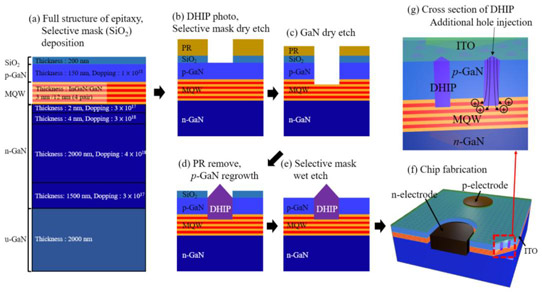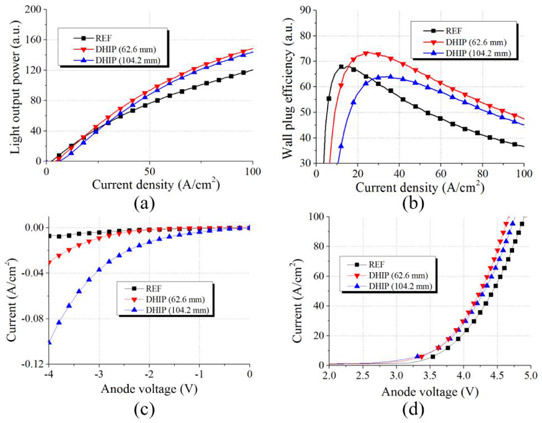- News
5 April 2017
Direct hole injection plugs for indium gallium nitride light-emitting diodes
Researchers in South Korea have used direct hole injection plugs (DHIPs) in indium gallium nitride (InGaN) light-emitting diodes to improve light output power and wall-plug efficiency (WPE) at higher currents [Sungjoon Kim et al, Optics Express, vol25, p6440, 2017].
Poor hole injection reduces the effectiveness of InGaN LEDs, and DHIPs are an attempt to overcome this. Seoul National University, Samsung Electronics Co Ltd and Gachon University in South Korea used LED material grown on 2-inch c-plane sapphire. The target wavelength was 445nm. The DHIPs were formed by dry etch with a plasma-enhanced chemical vapor deposition (PECVD) silicon dioxide mask, followed by filling with epitaxial p-GaN.

Figure 1: DHIP LED fabrication process and schematic of mechanism for increased hole injection.
The etch depth reached down to the multiple quantum well (MQW) layers, leaving three of the four wells intact, preventing loss of active region and excessive overflow of carriers and leakage at high operating current. The researchers used time-control to determine the etch end-point, but they suggest that detection of indium in the etch equipment could also be used as a signal. The etched circular holes were completely filled and capped with hexagonal pyramid islands, resulting from particular facet directions.
After removal of the silicon dioxide mask, lateral LEDs were fabricated with 440μmx370μm active area. An indium tin oxide (ITO) transparent p-electrode was used for current spreading.

Figure 2: Comparison of optical and electrical performances of reference, and DHIP LEDs having total circumferences of 62.6mm and 104.2 mm. (a) Measured light output power versus current density. (b) Wall plug efficiency versus current density. (c) Reverse leakage current density versus anode voltage. (d) Forward current density versus anode voltage.
With 3μm-radius DHIPs, improved power output and droop performance was seen at higher current in devices with a total DHIP circumference of 62.6mm, compared with a reference LED with no DHIPs (Figure 2). The increase in light output power was 23.2% at 100A/cm2 injection current. Comparing with an LED with 104.2mm-circumference DHIPs, the output power and wall-plug efficiency was better in the 62.6mm-circumference device.
The DHIP devices showed more reverse-bias leakage, but also had lower turn-on voltage – 0.25V less for 62.6mm total circumference and 100A/cm2 current density. The team comments: “It seems that the leakage path originates from the plasma damage and defects along the DHIP edge. Therefore, the total length of DHIP edge needs to be minimized to achieve higher optical output power and lower leakage current at the same time.”
By analyzing electroluminescence decay behavior from 4μs pulses, the researchers decomposed the Shockley-Read-Hall (SRH), radiative and ‘Auger’ recombination according to the ABC model (Table 1).
Table 1: Calculated recombination parameters (A, SRH, B, radiative, and C, Auger recombination).
| A (/s) | B (cm3/s) | C (cm6/s) | |
| REF LED | 4.7x106 | 1.8x10−11 | 1.5x10−31 |
| DHIP LED (104.2 mm) | 7.6x106 | 2.4x10−11 | 1.5x10−31 |
| DHIP LED (62.6 mm) | 6.0x106 | 2.5x10−11 | 1.5 x 10−31 |
The A coefficient is linear in carrier density (n), and is attributed to SRH recombination through defect levels. The quadratic (n2) B coefficient represents the desired radiative recombination of electrons and holes. Finally, the C coefficient gives a cubic (n3) dependence, which is often associated with non-radiative three-carrier energy transfers.
The DHIPs increase radiative recombination (B), but at the expense of increased SRH recombination (A). The trade-off gives the improved performance of the 62.6mm-circumference LED.
A large run of different DHIP radii (2-3.5μm) and circumferences (up to 300mm) suggested that an optimum circumference was around 70mm for 75A/cm2 injection current.
Direct hole injection plugs InGaN InGaN LEDs
www.osapublishing.org/oe/abstract.cfm?uri=oe-25-6-6440
The author Mike Cooke is a freelance technology journalist who has worked in the semiconductor and advanced technology sectors since 1997.


